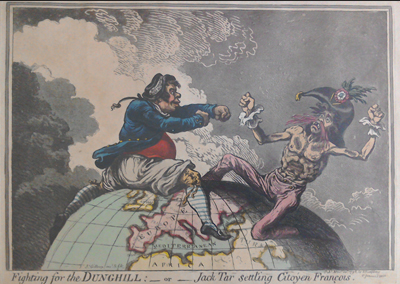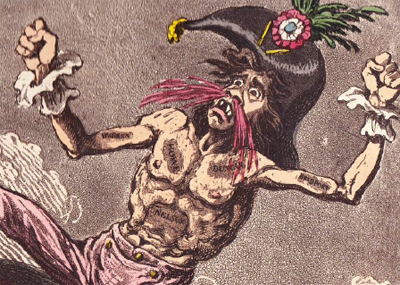Fighting for the Dunghill,
or Jack Tar Settling Citoyen François
This is the rare first state of a print with the same publication date later renamed Fighting for the Dunghill, or Jack Tar Settling Buonaparte
.

[November 20, 1798]
© Omek Marks, Private Collection
It is one of seven prints celebrating Horatio Nelson's victory over the French fleet at the Battle of the Nile. In earlier prints, Gillray had focused on the reactions to Nelson's triumph by the most prominent Whigs (Nelson's Victory, or Good-News Operating upon Loyal Feelings), on Nelson as a leader and the results of the battle (Extirpation of the Plagues of Egypt), and on the potential death of the Revolution itself (Destruction of the French Collossus). Here he sees Nelson's victory as the latest punch in a boxing match between two nations for a prize of nothing less than world domination, the whole "Dunghill."
In some ways, this state of Fighting for the Dunghill is a throwback to early Gillray prints such as National Discourse (1780) and Dutchman in the Dump (1781) which used national symbols for their satire rather than the caricature of specific individuals. England is represented by a well-fed and pugnacious Jack Tar, wearing a hat that announces "Britannia Rules the W[aves]" while France is the half starved and effeminate figure familiar to Gillray's audience as far back as the Macaroni prints and mezzotints like An English Jack-Tar giving Monsieur a Drubbing (1788).

or Jack Tar Settling Citoyen François
[November 20, 1798]
© Omek Marks, Private Collection
In this print as well, Citoyen François seems to be getting the worst of it. Jack is stepping forward out of an area of darkened clouds into an area of light as if putting British failures behind him. Correspondingly, Citoyen François is falling away from Jack Tar's onslaught into the shadows with a nose spouting whisker-shaped streams of blood. His body is covered with bruises identified with the names of the British admirals who struck major blows against the French. On the right arm, the bruise is labeled "Warren;" on the left arm, "Bridport" on the right breast, "Howe;" on the left breast, "Duncan;" and on the solar plexus, "Nelson."
But the print that most clearly relates to this one is John Bull Taking a Luncheon, or British Cooks Cramming old Grumble-gizzard, with Bonne-chére published in the previous month. (10/24/1798). In that print, England was also represented by another well-fed and pugnacious British symbol, John Bull, and as here, Nelson's triumph, though foregrounded was seen as only the latest in a series of British victories against France (the dishes all feature ships with French flags) being served up by British Admirals. And, indeed all the names appearing in Fighting for the Dunghill, or Jack Tar Settling Citoyen François appeared earlier as "dishes" in John Bull Taking a Luncheon. . ..

or British Cooks Cramming old Grumble-gizzard, with Bonne-chére
[October 24, 1798]
© Beinecke Rare Book and Manuscript Library, Yale University
Sources and Reading
- Commentary from the British Museum on Fighting for the Dunghill, or Jack Tar Settling Buonaparte.
- Draper Hill, Mr. Gillray The Caricaturist, 1965, p. 125
- Draper Hill, The Satirical Etchings of James Gillray, 1976 #61
- "Jack Tar," Wikipedia
- "John Borlase Warren," Wikipedia
- "Alexander Hood, 1st Viscount Bridport," Wikipedia
- "Richard Howe, 1st Earl Howe," Wikipedia
- "Adam Duncan, 1st Viscount Duncan," Wikipedia
- "Horatio Nelson, 1st Viscount Nelson," Wikipedia
- "Napoleon," Wikipedia
- Thomas Wright and R.H. Evans, Historical and Descriptive Account of the Caricatures of James Gillray #212
- Thomas Wright and Joseph Grego, The Works of James Gillray, the Caricaturist; With the History of His Life and Times p. 248.
Comments & Corrections
NOTE: Comments and/or corrections are always appreciated. To make that easier, I have included a form below that you can use. I promise never to share any of the info provided without your express permission.